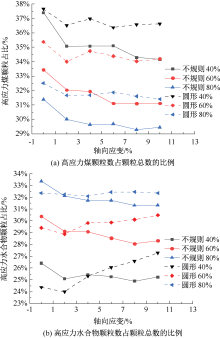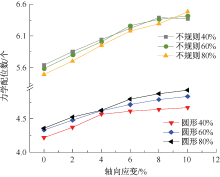| [1] |
张美长, 白晨浩, 祁云, 等. 含水率影响下煤样拉伸与压缩力学特性试验[J]. 中国安全科学学报, 2024, 34(6):146-156.
doi: 10.16265/j.cnki.issn1003-3033.2024.06.0104
|
|
ZHANG Meichang, BAI Chenhao, QI Yun, et al. Experimental study on tensile and compressive mechanical properties of coal samples under influence of water content[J]. China Safety Science Journal, 2024, 34(6):146-156.
doi: 10.16265/j.cnki.issn1003-3033.2024.06.0104
|
| [2] |
WU Qiang, HE Xueqiu. Preventing coal and gas outburst using methane hydration[J]. Journal of China University of Mining & Technology, 2003, 13(1): 7-10.
|
| [3] |
吴强, 张保勇. 煤体中瓦斯水合固化的力学作用研究进展[J]. 煤炭学报, 2024, 49(2):720-738.
|
|
WU Qiang, ZHANG Baoyong. Progress in the mechanical effects of gas solidification by hydrate in coal[J]. Journal of China Coal Society, 2024, 49(2):720-738.
|
| [4] |
张保勇, 高橙, 高霞, 等. 高饱和度下含瓦斯水合物煤体应力-应变特性试验研究[J]. 采矿与安全工程学报, 2018, 35(2): 429-435.
|
|
ZHANG Baoyong, GAO Cheng, GAO Xia, et al. Experimental research on stress-strain behavior of gas hydrate-bearing coal with high saturation[J]. Journal of Mining & Safety Engineering, 2018, 35(2): 429-435.
|
| [5] |
CUNDALL P A, STRACK O D L. A discrete numerical model for granular assemblies[J]. GÉotechnique, 1979, 29(1): 47-65.
|
| [6] |
KRUGGEL-EMDEN H, RICKELTS, WIRTZ S, et al. A study on the validity of the multi:sphere discrete element method[J]. Powder Technology, 2008, 188(2): 153-165.
|
| [7] |
杜锋, 王凯, 孙加智, 等. 单轴压缩下不同倾角煤岩组合体力学特性及破坏特征[J]. 中国安全科学学报, 2024, 34(6):136-145.
doi: 10.16265/j.cnki.issn1003-3033.2024.06.0785
|
|
DU Feng, WANG Kai, SUN Jiazhi, et al. Mechanical properties and failure characteristics of coal rock combinations with different inclination angles under uniaxial compression[J]. China Safety Science Journal, 2024, 34(6):136-145.
doi: 10.16265/j.cnki.issn1003-3033.2024.06.0785
|
| [8] |
BRUGADA J, CHENG Y P, SOGA K, et al. Discrete element modelling of geo-mechanical behavior of methane hydrate soils with pore-filling hydrate distribution[J]. Granular Matter, 2010, 12(5): 517-525.
|
| [9] |
JIANG Yujing, GONG Bin. Discrete-element numerical modelling method for studying mechanical response of methane-hydrate-bearing specimens[J]. Marine Georesources & Geotechnology, 2020, 38(9): 1082-1096.
|
| [10] |
张翀, 舒赣平. 颗粒形状对颗粒流模拟双轴压缩试验的影响研究[J]. 岩土工程学报, 2009, 31(8): 1281-1286.
|
|
ZHANG Chong, SHU Ganping. Effect of particle shape on biaxial tests simulated by particle flow code[J]. Chinese Journal of Geotechnical Engineering, 2009, 31(8): 1281-1286.
|
| [11] |
孔亮, 彭仁. 颗粒形状对类砂土力学性质影响的颗粒流模拟[J]. 岩石力学与工程学报, 2011, 30(10): 2112-2119.
|
|
KONG Liang, PENG Ren. Particle flow simulation of influence of particle shape on mechanical properties of quasi-sands[J]. Chinese Journal of Rock Mechanics and Engineering, 2011, 30(10): 2112-2119.
|
| [12] |
史旦达, 周健, 刘文白, 等. 砂土直剪力学性状的非圆颗粒模拟与宏细观机理研究[J]. 岩土工程学报, 2010, 32(10): 1557-1565.
|
|
SHI Danda, ZHOU Jian, LIU Wenbai, et al. Exploring macro- and micro-scale responses of sand in direct shear tests by numerical simulations using non-circular particles[J]. Chinese Journal of Geotechnical Engineering, 2010, 32(10): 1557-1565.
|
| [13] |
史旦达, 周健, 刘文白, 等. 砂土单调剪切特性的非圆颗粒模拟[J]. 岩土工程学报, 2008, 30(9): 1361-1366.
|
|
SHI Danda, ZHOU Jian, LIU Wenbai, et al. Numerical simulation for behaviors of sand with non-circular particles under monotonic shear loading[J]. Chinese Journal of Geotechnical Engineering, 2008, 30(9): 1361-1366.
|
| [14] |
张保勇, 于洋, 高霞, 等. 卸围压条件下含瓦斯水合物煤体应力-应变特性试验研究[J]. 煤炭学报, 2021, 46(增1): 281-290.
|
|
ZHANG Baoyong, YU Yang, GAO Xia, et al. Stress-strain characteristics of coal mine gas hydrate-coal mixture under confining pressure unloading[J]. Journal of China Coal Society, 2021, 46(S1): 281-290.
|
| [15] |
孙叶, 谭成轩. 中国现今区域构造应力场与地壳运动趋势分析[J]. 地质力学学报, 1995, 1(3): 1-12.
|
|
SUN Ye, TAN Chengxuan. An analysis of present-day regional tectonic stress field and crustal movement trend in China[J]. Journal of Geomechanics, 1995, 1(3): 1-12.
|
| [16] |
WANG Youhang, LEUNG S C. Characterization of cemented sand by experimental and numerical investigations[J]. Geotech Geoenviron Eng, ASCE, 2008, 134(7): 992-1004.
|
| [17] |
石崇. 颗粒流数值模拟技术与应用[M]. 北京: 中国建筑工业出版社,2018:177-178.
|
| [18] |
YONEDA J, JIN Y, KATAGIRI J, et al. Strengthening mechanism of cemented hydrate-bearing sand at microscales[J]. Geophysical Research Letters, 2016, 43(14): 7442-7450.
|
| [19] |
尹小涛, 葛修润, 李春光, 等. 基于数值实验的岩石试样最佳长径比研究[J]. 岩石力学与工程学报, 2010, 29(增2): 3608-3615.
|
|
YIN Xiaotao, GE Xiurun, LI Chunguang, et al. Study of optimal length-diameter ratio of rock specimen based on numerical tests[J]. Chinese Journal of Rock Mechanics and Engineering, 2010, 29(S2): 3608-3615.
|
| [20] |
王楠楠, 高霞, 张吉哲, 等. 基于平行黏结模型的含瓦斯水合物煤体宏细观力学性质研究[J]. 煤炭学报, 2024, 49(增1): 314-326.
|
|
WANG Nannan, GAO Xia, ZHANG Jizhe, et al. Macro-micro mechanical behavior research on gas hydrate bearing coal based on parallel bonding model[J]. Journal of China Coal Society, 2024, 49(S1): 314-326.
|
| [21] |
周世琛, 霍文星, 周博, 等. 柔性边界三轴压缩条件下胶结型水合物沉积物力学特性的离散元模拟[J]. 中南大学学报:自然科学版, 2022, 53(3): 830-845.
|
|
ZHOU Shichen, HUO Wenxing, ZHOU Bo, et al. DEM simulation of triaxial test on cementing type gas hydrate-bearing sediments under flexible boundary condition[J]. Journal of Central South University:Science and Technology, 2022, 53(3): 830-845.
|
| [22] |
孙其诚, 辛海丽, 刘建国, 等. 颗粒体系中的骨架及力链网络[J]. 岩土力学, 2009, 30(增1): 83-87.
|
|
SUN Qicheng, XIN Haili, LIU Jianguo, et al. Skeleton and force chain network in static granular material[J]. Rock and Soil Mechanics, 2009, 30(S1): 83-87.
|
| [23] |
PETERS J F, MUTHUSWAMY M, WIBOWO J, et al. Characterization of force chains in granular material[J]. Physical Review E, 2005, 72(4):DOI: 10.1103/PhysRevE.72.041307.
|
| [24] |
SUN Qicheng, JIN Feng, LIU Jianguo, et al. Understanding force chains in dense granular materials[J]. International Journal of Modern Physics B, 2010, 24(29): 5743-5759.
|





























